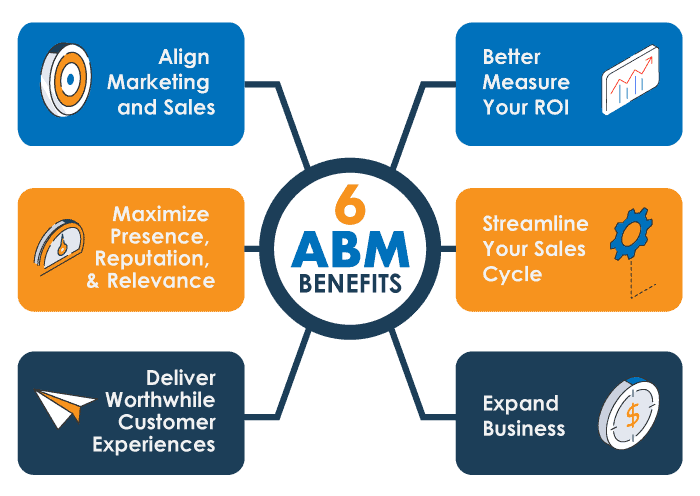
Account-based marketing (ABM) isn’t new to the B2B world – but it is ever-evolving. As a reliable strategy for businesses for the past 15 years, it’s still growing rapidly in potential. And while it’s been around for over a decade, only in recent years has ABM seen a surge in utilization.
Marketers that report using ABM shot from 15% in 2020 to 70% in 2021, according to the State of Marketing Report for 2022. And 71% of B2B organizations surveyed are interested in adopting ABM strategies, according to a separate report. They either already use account-based marketing tactics or are in the testing stages.
So – what changed? Why are so many more marketers and businesses leaping to take advantage of account-based marketing? We aim to be the all-inclusive guide on the subject.
Let’s look at some of the valuable questions companies may have about ABM, including what it is and why it’s so important. We’ll also cover creating a winning ABM strategy, what account-based marketing looks like in a B2B environment, and more.
What is Account-Based Marketing (ABM)?
Picture this: a B2B marketing strategy that turns the traditional marketing funnel entirely on its head. That’s what ABM aims to achieve.
Where traditional marketing strategies are about attracting, nurturing, and closing, ABM flips it upside down. Instead, account-based marketing is centered around identifying a customer, engaging, landing that customer, and then expanding the target audience. Let’s break that down further.
In short, account-based marketing is a strategy that uses personalized and highly targeted communication to gain business from a specific account or company. It’s targeted, sales-friendly, and works to match buyer expectations compared to traditional marketing.

Why is Account-Based Marketing Important?
By extending the involvement of marketing in the sales funnel, account-based marketing shortens the sales process. The strategy aims to save time, capital, and other resources by targeting ideal customers.
6 Benefits of Account-Based Marketing

1. Align Marketing and Sales
Few strategies are better at aligning marketing and sales than account-based marketing. According to a LinkedIn study, 82% of B2B marketers say that ABM vastly improves the alignment between sales and marketing.
Traditional tactics have marketing teams attract new leads for sales teams to then sift through. The result is often a mere handful of leads and even fewer sales.
Ultimately, account-based marketing aims to close on a single account or company. That means the marketing and sales teams can stay focused and work together on the same singular goal.
Instead of wasting time following up on unqualified leads that go nowhere, sales teams can nurture qualified, targeted leads. Marketing teams can build entire campaigns for specific accounts to leverage engagement and personalization on a whole new level.
2. Maximize Your Presence, Reputation, and Relevance
Since ABM focuses on individual accounts for marketing, you’ll, in turn, maximize your relevance with those high-value accounts. You’re already personalizing everything, which means you’re optimizing your presence in the space.
A valuable account-based marketing strategy tailors content and interactions in a way that shows an account how your specific products or services are exactly the solution to their challenge. ABM helps you angle your business to make it the most ideal, relevant option for your target accounts.
3. Deliver Consistent, Worthwhile Customer Experiences
As mentioned earlier, ABM works to match buyer expectations – or exceed them. By delivering products or services that consistently exceed expectations, you can ensure customers always have a worthwhile experience.
It’s necessary to maintain a long-term sense of satisfaction with your accounts. Each account should individually feel as though they are getting the primary focus of your attention and strategies.
4. Better Measure Your ROI
It’s easier to measure your ROI (return on investment) for each account you invest in with account-based marketing. The strategy takes a personalized approach to each account. You can, in turn, see the time and other resources invested in each account.
For CFOs and other ROI-focused individuals within a business, it’s good to note that ABM is the top marketing channel for generating a positive return on investment. In other words, account-based marketing outperforms other marketing initiatives, especially regarding ROI.
Further research acknowledges that the investment made in ABM delivers the same, somewhat higher, or significantly higher returns than other marketing tactics. That makes the process a zero-waste strategy.
5. Streamline Your Sales Cycle
ABM streamlines the sales cycle by allowing your business to focus on specific target accounts. By focusing on high-value targets, you save time and other resources.
Account-based marketing allows you to spend more time on specific sales cycle stages than traditional marketing. These stages positively impact the bottom line.
Every step, from aligning marketing and sales to personalizing customer experiences, is designed to streamline the sales cycle.
It simplifies it into four steps:
- Identify
- Present
- Close
- Delight
6. Expand Business
ABM is all about building up account relationships. Since the strategy is all about personalization and investing time and resources towards specific accounts, and your reputation improves positively with those accounts, you’ll also expand business through these account relationships.
By building trust and a reputation with these accounts, you’ll retain them as customers for much longer. Since it costs 4 to 10 times less to retain a customer than acquire a new one, this is a valuable factor for business.
In other words, it costs more to obtain new customers than it does to retain current customers. Therefore, focusing on maintaining that positive relationship with existing accounts will also improve your bottom line.
What’s a Typical ROI for Account-Based Marketing Efforts?
We know that ABM can outperform other marketing investments regarding ROI – but what numbers can you expect? The typical ROI for account-based marketing efforts varies by field and depends on whether your ABM program is complete.
According to DemandBase, 63% of companies with complete account-based marketing programs report at least a 25% ROI. 46% report at least a 50% ROI. Some even report a 2x and 3x return.
It all comes down to the specific ABM tactic in place. From the right account-based marketing platforms to the strategy itself, it’s important to understand what goes into creating a winning ABM strategy.
How to Create a Winning ABM Strategy
So far, we’ve examined what ABM is and its benefits in B2B. We also looked at some examples of what account-based marketing looks like in real time.
Maybe you’re launching an ABM program for the first time or trying to improve upon the account-based marketing plan you already have.
Regardless, you’re here to learn how to create and deliver an ideal strategy to your target accounts. Let’s examine the variables you need to start your first campaign. We’ll also observe account-based marketing best practices and go from there.

Identify Your Ideal Customer
The first step to an effective ABM plan is clearly defining your target audience. Build an ICP (ideal customer profile) of the type of company you want to do business with the most.
Your ICP includes knowing which industry best fits your product or service. It should also incorporate the ideal company size for the business you wish to work with.
Once you have your ICP, see which accounts match up to your newly created persona. Identify a list of target accounts from there.
Targeting ideal accounts is one of the top challenges when creating a winning ABM strategy, so take your time with this one. It’s okay to go into the research phase and come back here once you need to reassess your ICP. As account-based marketing is always evolving, so should your strategy.
Research Each Target Account
A mere 42% of B2B marketers say they have conversations with their ideal accounts as part of their content research phase. Without conversing with your ideal customers, you may accidentally create content that doesn’t truly resonate with them.
Irrelevant content is the number one reason buyers don’t engage with a brand – so ensuring content is consistently relevant is integral.
Use this step in your ABM strategy to gather inspiration for creating engaging content. Ask applicable questions and try to discover pain points, if possible. The goal is to build content that moves a customer from one stage to the next. It’s also critical for nurturing leads and influencing the buyer in the right direction.
During this research phase, try to learn the customer’s industry, company size, and potential competitors. Find out their revenue and, if possible, their marketing share and revenue history.
Discover the company’s key influencers and people with management or buying power. Learn about the relationships between each team member and try to understand the organizational structure, at least to a degree.
The bright side is that most of this information should already be publicly available. You’ll find it in annual reports, press releases, and likely directly on the company website.
Envision Your Buyer’s Journey
Don’t perform a marketing campaign until you’ve visualized the key takeaways decision makers in a business will take away from it. Is your message tailored to the appropriate audience? Does it entice and delight decision-makers in an account?
As you go into the next step of creating content, think about the key takeaways people will have. Deliver messages based appropriately on where someone is in their sales journey. The content you deliver will change depending on what stage they’re at.
It’s also helpful to build content for each stage in the sales cycle so that you can easily move a buyer from one stage to the next.
Create Targeted, Personalized Content
The next, possibly most important step is to develop your customized marketing campaign for each account. This step includes creating the targeted, personalized content you’ve been gathering inspiration for.
Using the data you learned in the research stage to inform your strategy, you can develop creative assets that resonate with your target market. Personalized, relevant content is the key to success regarding account-based marketing.
That’s because the more relevant and personal the content to your target account, the more likely they are to become customers.
Among all the effective ABM marketing tactics, personalized content easily outperforms all other strategies. It’s a must for your plan.
The length you want to go to make your content relevant is entirely up to you. For example, maybe you’ll create content tailored for a specific industry. Alternatively, you might create content that’s tailored to specific accounts or even roles within those accounts.
You can get as personal as you want – though there’s obviously a limit before things start to get weird.
Pro-Tip:
Educate and inform, Don't Sell
One of the best ABM strategies is to engage your target accounts with educational, informative content. A typical but effective ABM approach is to deliver a variety of powerful tools that help attract target accounts.
That includes everything from whitepapers and webinars to workbooks and infographics. Utilize blog posts and informative guides to position your company as the defacto source for that information.
Time Your Message Appropriately
A brand new account where your points of contact need to be educated on your product or service differs vastly from a contact you’ve already landed a sale with. You’ll personalize your message and time it appropriately to best navigate a customer to the next stage.
New Customers
Content for new accounts should be informative and educational. It can include blog posts, videos, and infographics explaining your company’s solution to the new accounts’ pain points.
Prospective Leads
Next, warm up these new accounts further by delivering more informative content that covers similar ICPs. These personas have been successful thanks to your company, and you can show off customer testimonial videos or case studies to demonstrate your success.
Nurtured Leads
Once nurtured, it’s time to get into the details for your potential customers. In this opportunistic stage, content should demonstrate a competitive analysis of what your company has to offer. It should show off ROI numbers and provide a smooth onboarding and implementation process.
The goal is for you to be at the top of a decision-maker’s mind when they’re ready to buy.
Returning Customers
Marketing doesn’t stop just because you’ve secured the first sale. Customers can now become advocates for your product or service. Through authentic word-of-mouth marketing, you can start landing and expanding further.
Content for this stage should include guides to make it easy for customers to adopt the service or product, checklists, and even video tutorials. The barrier to entry should be minimal.
Measure the Account’s Results
Lastly, it’s time to measure your campaign’s success. It’s necessary to understand which campaign is working and which needs improvement to consistently have a winning ABM strategy.
You can measure each account’s results based on various success metrics.
These metrics can include contacts in the account. Did you reach out to the right people? How many influencers did you connect with throughout the campaign?
Metrics can also include stage progression. Did you successfully move an account from one stage to another? Maybe you onboarded a new account. Or, maybe you were able to upsell to a previous account to continue the sales cycle.
Wrapping Up
Once you have a handle on your own account-based marketing framework, you’ll start seeing the same success other B2B marketers have seen. With the best practices in mind, we hope this guide helps you have a better understanding of ABM.
Account-based marketing isn’t new – but, as you can see, it’s always changing. And it doesn’t have to be overwhelming, either. By working through your ABM strategy one step at a time, you’ll be tackling best practices in no time.



